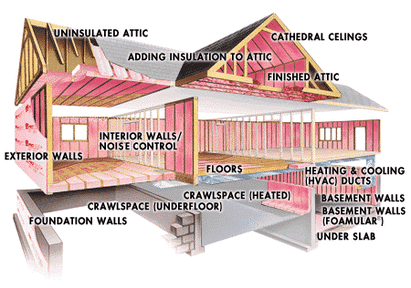As discussed in the paragraph above, insulating helps to keep your home snug as a bug in a rug. I’m confident that you can probably guess that there are other reasons to insulate too! And you’re right! One of the best reasons to insulate is the money you save.
Here’s an example. You have an attic. This attic is uninsulated, or if it is, it’s poorly insulated. What this translates to is all your heat, and essentially your money, going up and out through your roof. Thus, you’d insulate your attic and the problem is solved!
Insulating helps your home retain not only your heat, but your cooling as well. By creating a thermal blanket—or the building science-y term, a “thermal envelope or boundary”—you’re stopping drafts and keeping your home comfortable.
The key important places to insulate are shown in the diagram below.
Types of Insulation and where to put it
When it comes to choosing the type of insulation, a lot of your decision will depend on where you’re insulating. It’s also good to know
Batts and Rolls- This form of insulation is made from one of the following: fiberglass, rock wool, plastic fibers and natural fibers. For the most part, you want to place this type of insulation unfinished walls (foundation walls included), floors and ceilings. Batts and rolls are the easiest for do-it-yourselfers and more often than not fit between standard stud and joist spacing.
Foam board or Rigid Board- This is made polystyrene, polyisocyanurate, polyurethane. Rigid board tends to be way expensive compared to batts but, it is great for insulating unfinished foundation walls, unvented attics, attic hatches, floors, and ceilings. Considering it’s not very thick, it has a high insulating value.
Loose-fill or blown-in- This is either cellulose, fiberglass, or rock wool. For this form of insulation, you need a special set up with a machine and hoses, so it’s best to have a professional do it. You can this blown-in insulation on attic floors or enclosed, existing, walls. This is a really good insulation to choose when you’re looking at irregular shaped places.
Sprayed foam- Sprayed foam is best used in open, new wall cavities, unfinished attic floors, and enclosed existing walls. This is another form of insulation that is good around obstacles, in irregular areas or to add on existing finished areas. For best results, have a professional install this form of insulation.
Tips for Insulating
Now that you have some idea on what kind of insulation you want to use, and where, here are some extra tips to help you out.
· Be careful on how close you place insulation to light fixtures to avoid fire hazards.
· Use higher R-Value insulation on exterior walls and cathedral ceilings to get more insulation with less thickness.
· Check with a professional contractor for recommendations on where to insulate.
· Consider hiring a professional contractor insulate your home in order to get the most out of your investment and create a more comfortable home.
Hope this is helpful in your insulation journey!
